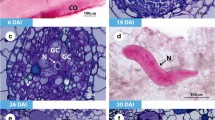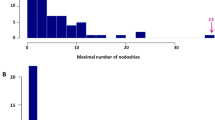Abstract
Experiments were designed to analyze the relationships between the root-knot nematodeMeloidogyne incognita and resistant tomato and pepper genotypes. From a natural avirulent isolate, near-isogenic nematode lineages were selected with virulence either against the tomatoMi resistance gene or the pepperMe3 resistance gene. Despite the drastic selection pressure used, nematodes appeared unable to overcome the pepperMe1 gene, therefore suggesting some differences in the resistance conferred byMe1 andMe3 in this species. Nematodes virulent onMi-resistant tomatoes were not able to reproduce onMe1-resistant nor onMe3-resistant peppers, and nematodes virulent onMe3-resistant peppers were not able to reproduce onMi-resistant tomatoes nor onMe1-resistant peppers. These results clearly demonstrate the specificity ofM. incognita virulence against resistance genes from both tomato and pepper, and indirectly suggest that gene-for-gene relationships could occur between these two solanaceous crops and the nematode.
Similar content being viewed by others
References
Cap GB, Roberts PA and Thomason IJ (1993) Inheritance of heatstable resistance toMeloidogyne incognita inLycopersicon peruvianum and its relationship to theMi gene. Theoretical and Applied Genetics 85: 777–783.
Castagnone-Sereno P (1994) Genetics ofMeloidogyne virulence against resistance genes from Solanaceous crops. In: Lamberti F, De Giorgi C and Mck Bird D (eds) Advances in molecular plant nematology (pp. 261–276) Plenum Press, New York
Castagnone-Sereno P, Bongiovanni M and Dalmasso A (1992) Differential expression of root-knot nematode resistance genes in tomato and pepper: evidence withMeloidogyne incognita virulent and avirulent near-isogenic lineages. Annals of Applied Biology 120: 487–492
Castagnone-Sereno P, Bongiovanni M and Dalmasso A (1993) Stable virulence against the tomato resistanceMi gene in the parthenogenetic root-knot nematodeMeloidogyne incognita. Phytopathology 83: 803–805
Dumas de Vaulx R, Chambonnet D and Pochard E (1981) Culturein vitro d'anthères de piment (Capsicum annuum L.): amélioration des taux d'obtention des plantes chez différents génotypes par des traitements à +35 °C. Agronomie 1: 859–864
Fassuliotis G (1987) Genetic basis of plant resistance to nematodes. In: Veech JA and Dickson DW (eds) Vistas on nematology (pp. 364–371) Painter EO, DeLeon Springs
Grant MW and Archer SA (1983) Calculation of selection coefficients against unnecessary genes for virulence from field data. Phytopathology 73: 547–551
Hendy H, Dalmasso A and Cardin MC(1985) Differences in resistantCapsicum annuum attacked by differentMeloidogyne species. Nematologica 31: 72–78
Hendy H, Pochard E and Dalmasso A (1985) Transmission héréditaire de la résistance aux nématodesMeloidogyne Chitwood (Tylenchida) portée par 2 lignées deCapsium annuum L.: étude de descendances homozygotes issues d'androgenèse. Agronomie 5: 93–100
Jarquin-Barberena H, Dalmasso A, de Guiran G and Cardin MC (1991) Acquired virulence in the plant parasitic nematodeMeloidogyne incognita. I. Biological analysis of the phenomenon. Revue de Nématologie 14: 299–303
Kaplan DT and Keen NT (1980) Mechanisms conferring plant incompatibility to nematodes. Revue de Nématologie 3: 123–134
Keen NT (1990) Gene-for-gene complementarity in plant-pathogen interactions. Annual Review of Genetics 24: 447–463
Roberts PA, Dalmasso A, Cap GB and Castagnone-Sereno P (1990) Resistance inLycopersicon peruvianum to isolates ofMi genecompatibleMeloidogyne populations. Journal of Nematology 22: 585–589
Thompson JN and Burdon JJ (1992) Gene-for-gene coevolution between plants and parasites. Nature 360: 121–125
Vanderplank JE (1968) Disease Resistance in Plants. Academic Press, New York
Yaghoobi J, Kaloshian I, Wen Y and Williamson VM (1995) Mapping a new nematode resistance locus inLycopersicon peruvianum. Theoretical and Applied Genetics 91: 457–464
Author information
Authors and Affiliations
Rights and permissions
About this article
Cite this article
Castagnone-Sereno, P., Bongiovanni, M., Palloix, A. et al. Selection forMeloidogyne incognita virulence against resistance genes from tomato and pepper and specificity of the virulence/resistance determinants. Eur J Plant Pathol 102, 585–590 (1996). https://doi.org/10.1007/BF01877026
Accepted:
Issue Date:
DOI: https://doi.org/10.1007/BF01877026




